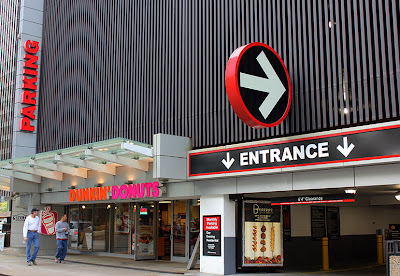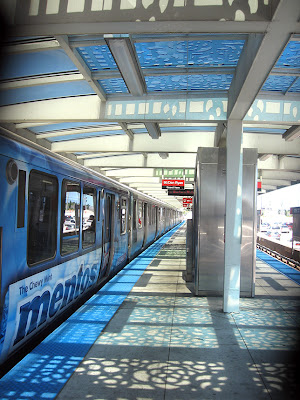 |
| click images for larger view |
Sam Jacob is in town. The brilliant British architect, a founding director of London's
FAT (Fashion Architecture Taste), is hot off his trip to Venice, poor man, where his
Museum of Copying was one of the hits of the 2012
Biennale. It would be nice to think his visit to Chicago might include the idea of bringing
Museum to Chicago.
Judging from Jacob's Instagram pictures, his visit to Chicago has been somewhat constricted in scope. There are photos of the river skyline, Louis Sullivan's Carson Pirie Scott ornament, Marina City at night, and also of MCA's just-closed
Skyscraper show. He posted pics both of Mies's IBM, and the adjacent
IBM Self-Park, captioned "Super massive black urban hole."
Jacob is surely not the first observer to draw the same conclusion. On a cloudy day, with flat light, the IBM Self-Park truly takes the form of a dark prison, sucking up all available light into the depths of its monolithic black form. There are many, I'm sure, who hate it for that. If it was the Self-Park's only trick, I might be among them.
But it's not, and the longer I live downtown the more I love this structure. I don't think I'm alone.
When IBM acquired the large parcel at Wabash and the river for its new tower, to be designed by Mies van der Rohe, it also acquired a slightly smaller parcel across Kinzie street, just to the north.
When the IBM opened in 1972, three years after Mies's death, it became an instant landmark, the
classic Miesian modernist box. No barnacle of a bustle like the Seagram, it soars 52 stories atop a raised plinth, on its own urban island, isolated in an enveloping ether of open space.
Mies's grandson Dirk Lohan has said that the IBM was deliberately sited to block the view from Michigan Avenue of the apostasy of Bertrand Golberg's curving, corn cob cylinders of Marina City. Like Marina City, however, the IBM was a pioneer in an old loft warehouse district that still often reeked of Skid Row. Someday, booming IBM would build a second tower and its parcel to the north - just not yet.
As Linda Legner wrote in
Inland Architect, May, 1974 . . .
Rather than let its smaller plot lie fallow for the duration, IBM went ahead with the second stage: IBM Self-Park, insisting that the design incorporate provision for the last phase of the project, the future addition of another tower atop the garage.
To design the self-park, IBM turned to young architect George Schipporeit, an even more insidious kind of heretic. Where Goldberg joyfully broke Mies's right-angled mode, Schipporeit merely bent it. His Lake Point Tower of 1968, designed with John Henrich, extruded the Miesian box, pulling the edges of the curtain wall out like taffy to form three curve-edged wings around a central core.
The $3.5 million IBM Self-Park would have a reinforced concrete frame, be 12 stories tall, and hold 800 cars. In deference to the IBM, the exterior would be metal, in this case Corten steel, the same self-oxidizing Corten that is Richard Serra's material of choice for his monumental sculptures. In place of the Miesian I-beam mullions, however, Shipporeit created a facade out of thin strips of vertical steel, very closely placed. The Corten starts out the color of rust, and then turns dark as it ages. although, as you can see above, the setting sun can bring it all out again.
The IBM Self-Park is often referred to as "sculptural". It curves at its southeast corner, mimicking the curve of Wabash itself, first west, then doubling back east, as it reaches Kinzie street. Descend the slightly scary open metal stair, and you can see how rain on the Corten steel has stained the concrete base of the building, raw and threatening, befitting the former abject character of its neighborhood.
What truly makes the IBM Self-Park sculptural, however, is not so much its form, as the way its steel screen interacts with the light. It is about as far from a black hole as you can get.
During the day, it plays with the sunlight, becoming a canvas of weird and wonderful patterns.
At night, like a vampire, it really comes to life.
As one of our readers noted, this is directly related to the form of the steel strips:
When looked at on end they are essentially 'Z' shaped. This has a big impact. The reason why the interior seems to play peek-a-boo as you move around the building is due to this shape. From some angles the shape of the steel completely blocks views into (or out of) the interior and from others they come close to disappearing. It is a deceptively simple building that does not give up its delights quickly.
At night, the actual structure of the garage is now clearly expressed. The screen dissolves into patterns of frame and void. Close up, viewed obliquely, those voids seem almost ghostly.
Step back, and the effect is astonishing.
The structural grid, hidden in daylight, reveals itself, as strong as bedrock, and those metal ribs, seemingly forming one impenetrable mass during the day, now look as fine as threads of silk. Within each frame of the grid, a bulb of light hovers, showing up the angled horizontals of the support beams. As cars move through the garage, their headlights animate the now diaphanous screen.
In the shorter, wider IBM Self-Park, Mie's elegant tower - Webern minimalism crossed with Gershwin swank - finds it perfect backdrop and counterpoint. Don't be fooled by the sometime dour demeanor; Schipporeit's IBM Self-Park is the sparkling Ninotchka of River North.






.jpg)










































